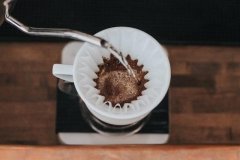[hand-brewing theory] the principle, tools and techniques of hand-brewing coffee

Professional coffee knowledge exchange more coffee bean information please follow the coffee workshop (Wechat official account cafe_style)
This time, I would like to talk to you about the principle of making coffee by hand. It can be simply understood as "scouring" and "soaking". Scouring refers to stirring with tools such as water flow or stirring sticks to strengthen the friction between coffee powder and water to make the substances in coffee powder dissolve in water, while soaking is to soak the coffee powder in water and take time to extract the taste.
Using laundry as an analogy, "scrubbing" means throwing off stains (coffee flavors), and "soaking" is soaking.
As the sour and sweet taste of coffee is easily soluble in water, it can be released as long as it is washed, while the sweeter substances are more difficult to dissolve, so it is necessary to add soaking to produce the flavor. Therefore, to control the balance of sweet, sour and bitter taste of a cup of coffee depends on the proportion of scouring and soaking: if you want to emphasize the sour and sweet taste of African coffee, you can use a higher proportion of scrubbing to reduce soaking; if you want to highlight the sweetness of Brazil, it is the opposite.
Choose the right tool to adjust the scour and immersion ratio. Take the filter cups of major brands as an example, the flow rate of Kalita and Melita filter cups is slower, the content of the cup is easy to store water and soak coffee powder, and the proportion of natural soaking is higher. Another brand Hario has a faster flow rate and a lower immersion ratio, and a higher scour ratio.
This also explains the need for cooperation between flushing techniques and filter cups. If the flow rate of the filter cup is slow and the flushing technique of strong stirring is used, it is easy to scrub and soak the coffee, resulting in boiling coffee, which is bitter and astringent; on the contrary, using the fast-flow filter cup, the flushing technique is too gentle, so that the effect of scouring and soaking is too weak, as a result, the coffee is "too raw" and will be light and sour.
Of course, there is no certainty, when you fully control the grinding degree and water temperature and other variables, use a slow-flow filter cup with fast flow, you can also make delicious coffee.
END
Important Notice :
前街咖啡 FrontStreet Coffee has moved to new addredd:
FrontStreet Coffee Address: 315,Donghua East Road,GuangZhou
Tel:020 38364473
- Prev

[hand theory] six factors that can change the taste of coffee during brewing
Professional coffee knowledge exchange more coffee bean information Please pay attention to Coffee Workshop (Wechat official account cafe_style) Coffee is an experimental science. Coffee can not be predicted entirely by theory, but it can improve the accuracy of experiments by learning theories, narrow the possible experimental results, and turn "unpredictable" into "predictable". In the process of brewing coffee
- Next

Grindability and extraction Progress of hand-brewed Coffee
Professional coffee knowledge exchange more coffee bean information Please follow the coffee workshop (Wechat official account cafe_style) saw a Taiwanese barista in Youtube earlier explaining why the coffee powder is thicker but the coffee brewed is more bitter. Contrary to the theory, I think it is worth considering and discussing, and tidying up the article. Sorry, the clip forgot to keep a record. Welcome to supplement the film.
Related
- Beginners will see the "Coffee pull flower" guide!
- What is the difference between ice blog purified milk and ordinary milk coffee?
- Why is the Philippines the largest producer of crops in Liberia?
- For coffee extraction, should the fine powder be retained?
- How does extracted espresso fill pressed powder? How much strength does it take to press the powder?
- How to make jasmine cold extract coffee? Is the jasmine + latte good?
- Will this little toy really make the coffee taste better? How does Lily Drip affect coffee extraction?
- Will the action of slapping the filter cup also affect coffee extraction?
- What's the difference between powder-to-water ratio and powder-to-liquid ratio?
- What is the Ethiopian local species? What does it have to do with Heirloom native species?

